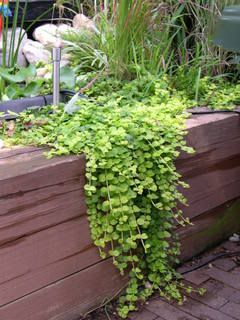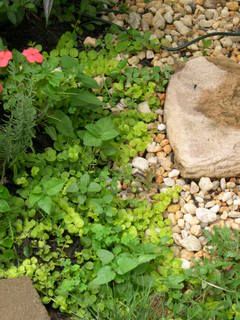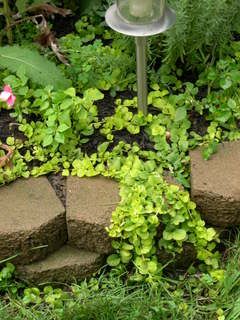Beware Creeping Jenny
It all seemed so innocent at the time ... about three years ago, while picking out plants for my ornamental pots, I came across a beautiful lime green vining plant that looked different from the usual sweet potato vines, vinca and bacopa. It's common name was Creeping Jenny.
Creeping Jenny, also known as moneywort, is a fast growing, prostrate plant with pairs or round, penny-sized leaves along the slender stems that snake out from the center of the plant. Plants grow about 2 inches tall but will spread as wide as space permits. And I do mean as wide as space permits.

I swear I only planted Jenny in my pots, but somehow, by the end of that first season, "she" managed to spread into the garden path, along the edge of the pond, and over a few of my flower beds that weren't even near the pots. Although it's a nice looking plant, I had no idea how absolutely invasive it is.

The most common form of creeping Jenny in local nurseries is the golden-leafed cultivar ‘Aurea’ which has bright, chartreuse leaves in the spring that take on a somewhat more subdued tone as they age.
A quick check of the Internet finds lots of people having trouble with this plant. One claims to have sprayed it with Round-Up, to no avail. Apparently it is very difficult to control because of its extensive root system.

However, there were some suggestions for controlling it. In turf situations, where cultivation is not practical, a postemergent herbicide is recommended. Small infestations in nonturf areas sometimes may be controlled by covering the area with mulch and not allowing any green plant material to emerge. Multiple applications may be required for complete eradication.
So try Creeping Jenny at your own risk, or let me know if you've already encountered this invasive groundcover and had any luck getting rid of it.

FYI -- I'll be on vacation and away from a computer for the next two weeks (whatever am I going to do without the Internet??) Anyway, I won't be posting any new entries until after Sept. 8. Then it'll be on to fall planting and prep. Till then ...
Creeping Jenny, also known as moneywort, is a fast growing, prostrate plant with pairs or round, penny-sized leaves along the slender stems that snake out from the center of the plant. Plants grow about 2 inches tall but will spread as wide as space permits. And I do mean as wide as space permits.

I swear I only planted Jenny in my pots, but somehow, by the end of that first season, "she" managed to spread into the garden path, along the edge of the pond, and over a few of my flower beds that weren't even near the pots. Although it's a nice looking plant, I had no idea how absolutely invasive it is.

The most common form of creeping Jenny in local nurseries is the golden-leafed cultivar ‘Aurea’ which has bright, chartreuse leaves in the spring that take on a somewhat more subdued tone as they age.
A quick check of the Internet finds lots of people having trouble with this plant. One claims to have sprayed it with Round-Up, to no avail. Apparently it is very difficult to control because of its extensive root system.

However, there were some suggestions for controlling it. In turf situations, where cultivation is not practical, a postemergent herbicide is recommended. Small infestations in nonturf areas sometimes may be controlled by covering the area with mulch and not allowing any green plant material to emerge. Multiple applications may be required for complete eradication.
So try Creeping Jenny at your own risk, or let me know if you've already encountered this invasive groundcover and had any luck getting rid of it.

FYI -- I'll be on vacation and away from a computer for the next two weeks (whatever am I going to do without the Internet??) Anyway, I won't be posting any new entries until after Sept. 8. Then it'll be on to fall planting and prep. Till then ...
Labels: creeping jenny, invasive plants, moneywort
 RSS
RSS



1 Comments:
Creeping Jenny can be good in areas where you can't get much groundcover to grow. I had my own problem with an invasive vine. It came with some Lobelia I bought, and slowly spread to the yard. It looks like a strawberry plant, but the leaves are huge and the stems have spikes on them that come off like cactus spikes when you touch it. It has a tiny white flower that doesn't look like much but spreads seeds everywhere. At first it looked lovely but now it's just a pain.
Post a Comment
Links to this post:
Create a Link
<< Home